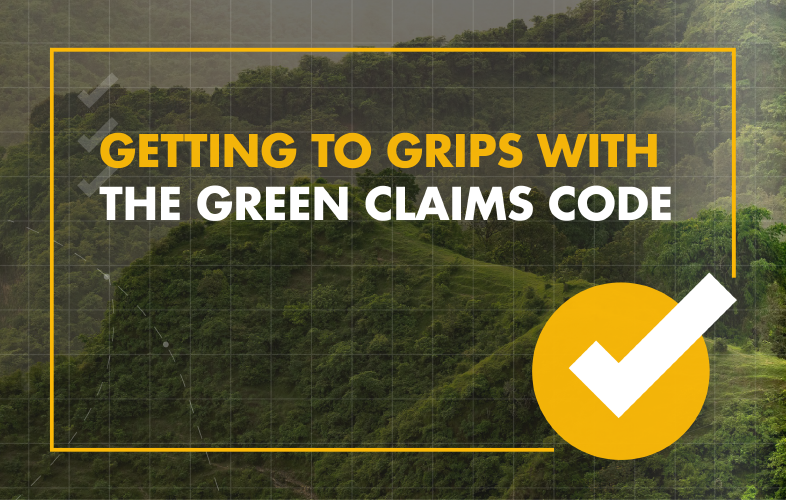Sustainable manufacturing is a key priority for thousands of businesses today, and awareness of the impact that manufacturing has on the earth has never been stronger. As a result, companies across the globe are making significant strides to reduce their carbon emissions and single-use plastic and devise more sustainable ways of delivering their products.
Understandably, these companies want to communicate their environmental progress to customers. And while the vast majority of businesses are honest and clear about the initiatives they’ve introduced to make their practices more eco-friendly, it’s also true that some companies make claims within their sustainability messaging that can be inaccurate, misleading or untrue.That’s why the Competition and Markets Authority (CMA) has developed the Green Claims Code, a checklist which sets out a series of key points so that businesses can check that the environmental claims they’re making about their product or service are accurate and don’t misinform the consumer. But it isn’t just the CMA who are trying to monitor and investigate green claims – the public are also being encouraged by the CMA and other environmental regulatory bodies to investigate and challenge the green claims made by companies from which they buy.
HOW V12 CAN HELP
When V12 launched its first carbon neutral safety boot range, as well as harnessing our team’s expertise and resources, we used the guidance in the Green Claims Code to ensure our sustainability messaging and claims were accurate, clear and not open to misinterpretation. And to help you guarantee your company’s claims are similarly factual and correct, we wanted to share some of the top learning moments from our journey to introducing a carbon neutral range. We’ll start with some green frequently asked questions and then provide you with some top green claims' guidance.
GREEN CLAIMS: FAQS
What does a company do when it makes a ‘green claim’?
When a company makes a claim of this type, it releases information that points out the positive impact their product or service has on the environment. Often this information is used to help promote their product or service.
What does a company do if it ‘greenwashes?’
If a company is seen to be greenwashing, it tells the public and its customers that its product is sustainable or environmentally friendly when it isn’t or exaggerates its positive environmental impact. Either way, this messaging is wholly or partially untrue, but the main takeaway is that the claim is misleading the public. And it isn’t an uncommon occurrence. According to Government statistics, ‘A recent international analysis of websites found that 40% of green claims made online could be misleading.’
Can a company accidentally make a misleading green claim?
Yes. A lot of company’s’ green claims have been found to be untrue, misleading or inaccurate because they haven’t conducted sufficient research into their product or service’s supply chain or have made calculations or projections that haven’t been rigorously developed or reviewed. Sometimes, even the wording of a slogan or product description can be ambiguous or open to misinterpretation, and this is also a form, however unintentional, of greenwashing.
Learn more about the CMA's green claims code in their video below.
THE GREEN CLAIMS CODE – A SUMMARY OF KEY POINTS
1. Facts are hard to argue with
You need: Up-to-date, credible evidence to show that your claim is true
If you’ve made claims related to the environmental impact of your product such as the number of shipping miles you’ve saved, the amount of carbon offsetting investments you’ve made or the levels of greenhouse gas (GHG) emissions that have been reduced from manufacturing, have your calculations ready. These numbers are essentially your evidence to support your claims should anyone ask. Essentially, you must be able to backup what you’re claiming.
The best thing to have at your disposal if your green claims are challenged are numbers. They’re difficult to argue with, and as long as they’ve been responsibly and accurately calculated, they’re the quickest and most effective way to show customers all the good you’ve been doing.
Finally, the world of sustainability changes frequently – a claim you made a month ago about your carbon emissions or recycled packaging processes might be inaccurate or out of date today, so keep updating your claims, and make sure you apply those changes across all your platforms. You don’t want your emails, website, blog and social media channels saying different things - it won’t look good for your brand, and it’ll make your green claims seem flimsy to say the least.
2. Tell the whole story
You need: to be specific about what part of the product or service your claim refers to
This is a crucial part of a green claim, because it’s an area where companies can – even accidently – mislead consumers. If you have a product which is more sustainable than other lines or is carbon neutral compared to other products in your range which aren’t, you must make this clear. Be specific, and don’t make sweeping statements when you’re referring to a small component of a wider range.

Similarly, it’s vital to remember that your product has a life cycle that might start at your head office or the factory and ends when it’s in your customers’ hands. So, it’s important to talk about the environmental impact your product has not just in terms of energy and materials used, but also things like:
- its packaging
- the carbon footprint of its shipping journey
- how it gets from port to store and the emission implications of this
- how this might vary if different factories supply particular components for your product
There’s a lot to consider – but it’s best to question yourself early on and get it right, rather than be questioned on it and find out you’ve got it wrong later.
3. The truth, the whole truth etc...
You need: claims which don’t exaggerate or contain untrue information
It’s understandable for a company to get excited and passionate about a product or service that has become more eco-friendly or revolutionises sustainable processes. And while you absolutely should broadcast the positive impact your goods are making on the environment; you must ensure your information is fact. Be careful not to exaggerate your emissions savings just because it fits a particularly clever or engaging strapline or it helps you include more items in your sustainable range. Save your creativity for product development and design – when it comes to green claims, stay factual.
4. Green vagueness is a red flag
You need: clearly set out and easy to understand information, including conditions and caveats
It’s possible that certain provisos apply to your claims that make your information more challenging to evidence such as shifting shipping prices or variables like emissions through transport – this type of data can often vary depending on which source or calculator is used. But these conditions or disclaimers should be just as easy to access as your headline green claims. Vagueness and lack of clarity is a greenwashing red flag, so transparency, even with the less marketable or clear-cut details is essential.
5. Make your information easy to find
You need: to provide easy access to all information (even the parts that aren’t very exciting)
Reporting on the sustainability practices in your company can often generate huge amounts of information – and so it should; it’s a massive topic. And it’s understandable that not all of this information can fit conveniently on an email, landing page or poster. But it does need to be accessible, because a lot of companies and customers base their purchasing decisions on the sustainability of the company’s whole manufacturing process.
Signpost it: direct your customers to an expanded blog, white paper or a fact sheet through links, QR codes and forms. People want to see the whole picture, so if your claims are factual and true, show it to them. If they’re not, you’ve got more work to do...
"while Vegan products are undoubtedly better for animals, it doesn’t always mean they’re better for the planet.”
6. Don't fall victim to misconceptions
This is an important one. A lot of companies slip up on their green claims by misunderstanding or misapplying their sustainability terms. Here are a couple to be aware of:
Sustainability and veganism
A lot of businesses associate sustainability with having a vegan range, but these are two separate practices and mean very different things. Having a vegan-friendly product means that no animal products have been used in production, and while this is good for animal welfare, it doesn't necessarily make it sustainable. Charlie Turner, Marketing Director at V12 Footwear explains:
“Vegan-friendly footwear will often use man-made microfibers such as PU or Nylon for the uppers as a substitute for leather. But plastic takes a lot longer to biodegrade than leather – so while vegan products are undoubtedly better for animals, it doesn’t always mean they’re better for the planet.”
So remember: veganism and sustainability are two different things, and they should never be used interchangeably when you’re promoting the environmental features of your goods.
Recycled plastic
There are also many misconceptions around the sustainability of recycled plastic. Charlie Turner talks us through a common misunderstanding:
‘There is a misconception around the sustainability of recycled plastic. Whilst recycling plastic is a must to ensure it can be used again and doesn't go into landfill, I understand that in nearly every case recycled plastic has a higher carbon footprint that virgin plastic. Where plastic has to be used then this is a great alternative but we should really be looking to remove plastic altogether in line with the global movement to reduce plastic’
So remember, if you're making a green plastic claim, recycling plastic sounds environmentally friendly, but often, it’s just as detrimental to the planet as virgin plastic production. Do your research and know your facts!
Reducing plastic at V12 Footwear
We've taken several steps to reduce single use plastic in our products, because small or large, each sustainability step makes an impact. Theses steps include:
- Swapping our old plastic hang tag attachments for ball bearing chains made of metal
- Removing the tissue previously inserted into our footwear
- Changing our shoe wrapping from plastic to paper
- Removing all plastic from our shoe boxes
For helpful and practical tips on how your company can reduce its single-use plastic use, read our blog here.
V12 FOOTWEAR’S SUSTAINABILITY JOURNEY
What we learnt:
When we launched our carbon neutral range, we did some valuable learning along the way which helped us ensure our green claims were statements we were proud of, we believed in and that were easy to evidence. We hope they help you.
1. We knew sustainability was a huge topic, so we researched it. Thoroughly. Often with green claims, it’s all in the detail, and that’s why before starting our sustainability messaging, we knew our carbon from our GHG and our offsetting from our capture. Being in the know means having faith in your messaging, and this is vital when making a green claim.
2. We never guesstimated or assumed. All data and information was obtained by regular meetings with all relevant departments of our company and the supply chain. When we were broadcasting our sustainability innovations, we had complete trust in the information we were publicising, because it had come from the experts and the correct sources.
3. There are professionals and companies who’ve devoted decades to the study of ecology and the environment. So, we learnt from them. We researched a range of companies thoroughly before we chose the one we thought best qualified to support us on our carbon footprint journey.
We also signed up to several global initiatives to educate us on business sustainability, support us on our continued journey and to set sustainability targets for the future.
4. We welcomed scrutiny. Because we conducted thorough research, made clear calculations and ensured that our claims were accurate, we weren’t worried about our claims being probed or challenged and have been open and transparent regarding our journey. With faith in our messaging and in our product, we were only too glad to discuss with other companies or customers the sustainability processes which we’re so proud of.
Find out how we made our Lynx safety boot range carbon neutral by clicking below.





